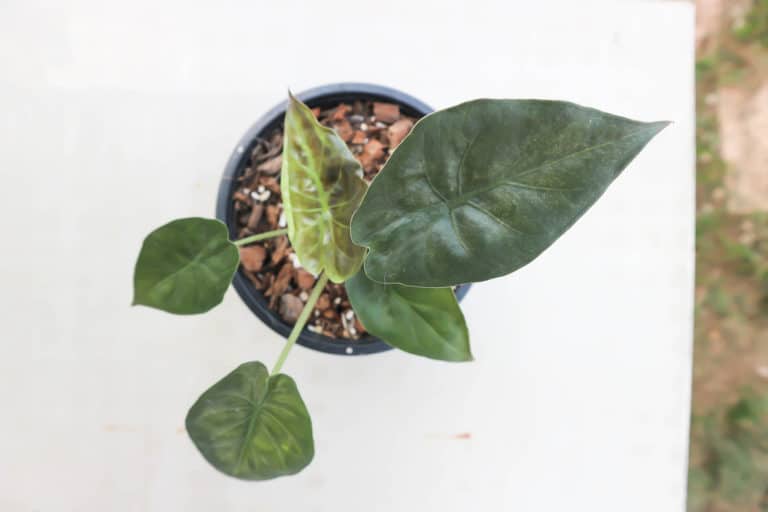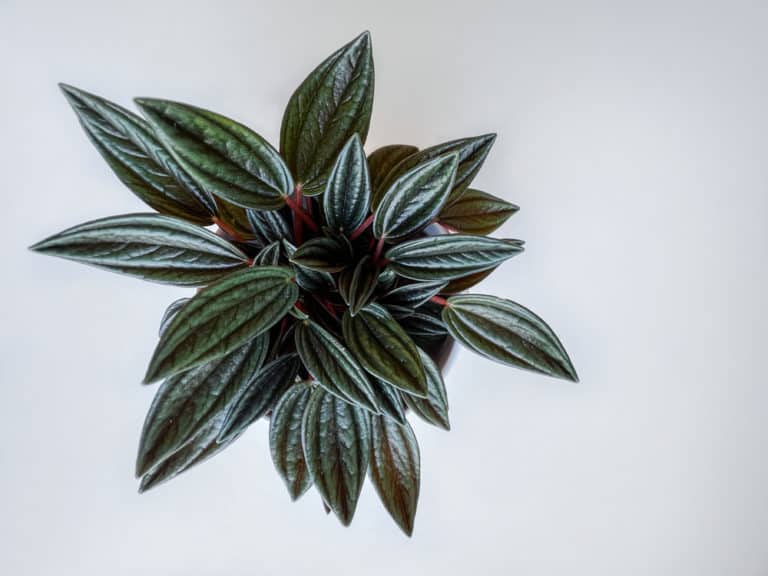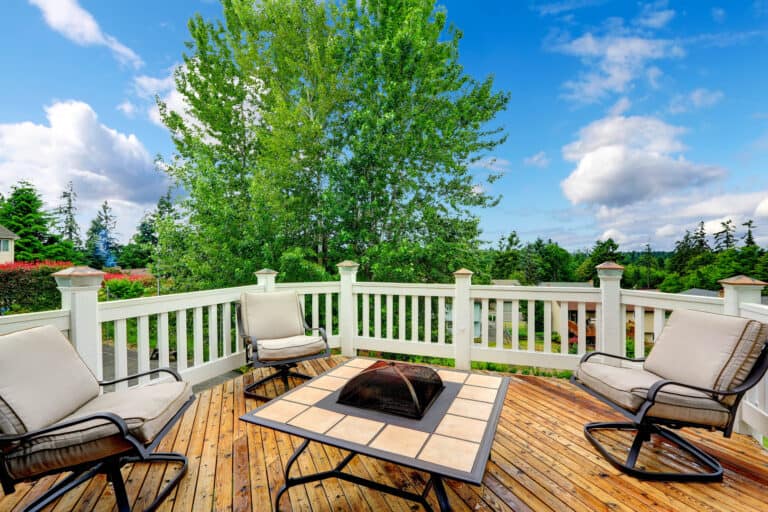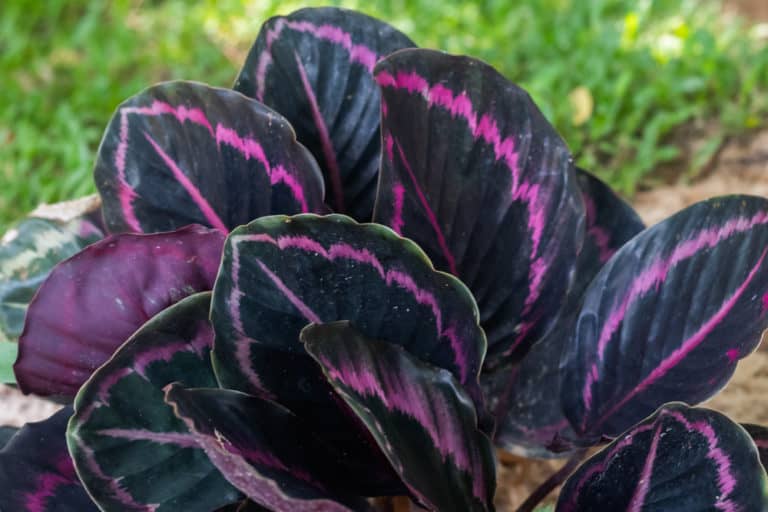Hoya Macrophylla ‘Variegata’ Care Guide (2024)

Hoya Macrophylla is a beautiful, low-maintenance vining plant that can be used in a variety of ways in your indoor garden.
Prized for its attractive leaves, one of its most sought-after cultivars is Hoya Macrophylla Variegata.
Whether you’re an experienced grower or a beginner, Hoya Macrophylla is one of the best plants to add to your collection.
| Scientific Name | Hoya Macrophylla Blume |
| Common Name | Hoya Macrophylla, Wax Plant |
| Light | Bright indirect sunlight |
| Watering | Water when soil is completely dry |
| Temperature | 65° to 80°F (18 to 26°C). |
| Hardiness Zone | 10-11 |
| Humidity | 40-90% |
| Soil Type | Porous, well-draining |
| Soil pH | 6.1 to 7.3 (slightly acidic to slightly alkaline) |
| Fertilizing | A balanced feed once a month in spring and summer |
| Repotting | Every 2-3 years |
| Pruning | Only to remove dead leaves |
| Propagation | Root in water or soil |
| Toxicity | Mildly toxic to most humans and pets |
| Mature Size | 5 to 7 feet as a houseplant |
| Bloom Time | Late spring, early summer |
What’s Unique About Hoya Macrophylla?
Native to the rainforests of Borneo in the South Pacific, the Hoya Macrophylla plant was first described in 1827. Since then, it has become an extremely popular houseplant because it’s so easy to grow.
Hoya Macrophylla plants are practically maintenance-free. Not only do they tolerate infrequent watering; they need their soil to dry out completely.
Because they are climbing vines, you can train them to grow wherever you like. The attractive waxy leaves are evergreen, providing year-round foliage to refresh your home or office.
If you are patient, after several years you may also get a sweet-smelling Hoya Macrophylla Variegata flower or two!
Hoya Macrophylla Care
Growing Hoya Macrophylla is very easy once you’ve met its few key growing conditions.
Basic Hoya Macrophylla plant care involves planting it in porous soil, keeping it out of the full sun, and surrounding it with warmth and humidity.
Once you’ve done that, your routine Hoya Macrophylla Variegata care consists of infrequent watering and fertilizing.
Light
In the Borneo rainforests where it originates, Hoya Macrophylla thrives under the tree canopy that shields it from the blazing rays of the tropical sun.
Thus, Hoya Macrophylla light requirements are for bright, indirect light, or between 10,000 and 20,000 lux.
You can usually accommodate these Hoya Macrophylla Variegata light needs by setting it by the north or east window. There, it will get the less intense morning light.
If you’re limited to a south or west exposure, you will need to move your Hoya Macrophylla further away from the windows to keep it out of the full sun.
Watering
The basic rule for Hoya Macrophylla watering is not much!
In the rainforests, Hoya Macrophylla often grows in cracks in rocks, so these plants have evolved to grow in very dry conditions.
In fact, if you water Hoya Macrophylla Variegata too much, it can die, so it’s important to understand its watering needs.
Let the soil dry out completely between waterings.
When it is time to water, take the pot and submerge it in a sink or pail of water. After it’s fully saturated, remove it and let all excess water drain out before returning it to its saucer. Never let the pot sit in water.
Temperature
The Hoya Macrophylla temperature range is 65° to 80°F (18 to 26°C). This is not surprising, considering its tropical origins.
You should be able to provide an adequate temperature for Hoya Macrophylla Variegata in your home or office without supplemental heating sources.
However, you should keep in mind that it has limited temperature tolerance below 55°F (12°C). It will not grow well if exposed for prolonged periods and eventually could die.
As well, it has no frost hardiness at all. Temperatures below 35°F (2°C) will kill it. In temperate zones, it can only be moved outdoors in hot summer weather.
Humidity
Hoya Macrophylla comes from the steamy tropical rainforests of the South Pacific, so the ideal humidity for Hoya Macrophylla Variegata is very high, as much as 90%.
However, it will tolerate a much lower humidity level, down to about 40%, without too much trouble.
If you want the lushest, healthiest leaves, you can try to get closer to the preferred Hoya Macrophylla humidity requirements without turning your whole house into a steam bath.
Using a water-filled pebble tray under the pot, or a small humidifier can elevate the humidity in the immediate vicinity of your Hoya Macrophylla.
You can also regularly mist the leaves with distilled water.
Soil
Hoya Macrophylla soil has to be porous, as its roots will rot and die in a saturated planting medium. They need air to live.
The recommended pH level for Hoya Macrophylla Variegata is 6.1 to 7.3, or slightly acidic to slightly alkaline.
Good soil for Hoya Macrophylla Variegata is a commercial cactus or orchid potting soil, with added perlite to further aerate the soil. Avoid using peat in your Hoya Macrophylla soil, as it will make the pH too acidic. Coco coir is a better choice.
The secret ingredient to add to your soil mix is crushed eggshells since Hoya Macrophylla thrives on calcium.
Fertilizer
You do not need to use a lot of fertilizer for Hoya Macrophylla Variegata, but occasional feedings will help keep it growing well.
The standard fertilizer ratio of 10-10-10 will be perfect for your Hoya Macrophylla fertilizer.
If you use a liquid fertilizer, dilute it to half or a quarter of the recommended strength, and add to the soil right after you’ve watered. Use it once a month in spring and summer.
You can also use an orchid foliar fertilizer spray. Dilute it to half strength and apply to the leaves in a very fine mist.
You should not use fertilizer during its dormant phase in winter.
Potting & Repotting
Hoya Macrophylla repotting only needs to be done every 2 or 3 years, as it is a slow-growing perennial which actually thrives on being root-bound.
The main reason for repotting Hoya Macrophylla Variegata is to refresh its soil. However, if the pot is all roots and no soil, or roots are growing out of the drainage holes, you should move it to a slightly bigger pot.
Otherwise, don’t increase the pot size, as it prefers a snug fit.
An unglazed clay or terra cotta pot is perfect for potting your Hoya Macrophylla, as it helps keep the soil dry and lets the roots breathe.
Pruning
You will not need to do much Hoya Macrophylla pruning.
As with any evergreen perennial, you will need to trim off any dead or damaged leaves, as they detract from the appearance and can harbor disease.
However, if you do want to control the size or shape of this vining plant, you can cut out any stems where they meet the main vine. Do this early during the growing season in spring.
If your Hoya Macrophylla flowers, you can cut off spent blooms, but leave the stalks as new flowers will bloom there.
When cutting Hoya Macrophylla Variegata, use a sharp sterilized knife or scissors.
Propagation
Hoya Macrophylla propagation is not difficult to do and will reward you with fresh new plants to keep or give away.
To propagate Hoya Macrophylla Variegata using stem cuttings, select stems with at least 2 nodes.
Cut them with sharp, sterilized scissors or knife. Strip all but 1 or 2 leaves from the stem tip, and put them in a jar of water or moistened sphagnum moss.
Keep them in a warm and humid spot out of the direct sun. If you use water, change it every few days. If they’re rooting in sphagnum, keep it consistently moist.
Within a month, you should have rooted cuttings to plant out in their own pots.
Also, make sure to check out our in-depth Hoya tricolor plant care guide.
Common Problems of Hoya Macrophylla
There are few Hoya Macrophylla problems, but no plant is entirely carefree.
Most problems with Hoya Macrophylla Variegata result from not paying close enough attention to its required growing conditions.
The leaves will usually alert you to any issues that need to be dealt with to keep your Hoya Macrophylla thriving.
Pests
There are not a lot of Hoya Macrophylla pests, but you may encounter mealybugs and aphids on the succulent leaves and stems of your Hoya Macrophylla Variegata.
Luckily, both these bugs are easy to eliminate, especially if you catch them early.
Mealybugs look like little tufts of cotton on the underside of the leaves. You may notice some yellowing and curling of the foliage.
Use a cotton ball soaked in rubbing alcohol to wipe them off, and spray with neem oil to keep them from returning.
Aphids are little green bugs. You should be able to control them with insecticidal soap or neem oil sprays.
Diseases
Most Hoya Macrophylla diseases can be prevented by not overwatering your Hoya Macrophylla Variegata.
However, if you do find a fungus disease on your Hoya Macrophylla, it’s not too late to save your plant.
If the leaves are yellow and the stems getting mushy, you probably have root rot from too-wet soil.
Remove the plant from its pot and trim off all black roots, as well as all affected leaves and stems. Repot it in fresh, porous soil and reduce your watering frequency.
If you see mold developing on the leaves of your Hoya Macrophylla, it’s not getting good enough air circulation. Trim out affected leaves and use a fan to keep the air moving.
Growing Problems
Not all growing problems are caused by disease or bugs. If you’ve got a sick plant, sometimes you just need to tweak your Hoya Macrophylla’s growing conditions.
If your Hoya Macrophylla vines are dying back, they may not be getting enough light. Move it to a brighter spot while still keeping it out of the full sun.
If the succulent leaves of your Hoya Macrophylla become wrinkled and thin, it needs water. Give it a good soaking in a pail and let all the excess water drain out. It should bounce back.
If new growth has stopped during its growing season, you may not have it in a warm enough spot. It needs temperatures above at least 55°F (12°C) and preferably higher.
Toxicity of Hoya Macrophylla
Hoya Macrophylla Variegata can be mildly toxic to humans and pets because its milky sap contains latex, which for most is an irritant at worst.
While its overall toxicity level is low, some people have a latex allergy, and for them, any exposure to the sap can have serious consequences.
For Humans
For most humans, the latex in the sap can just irritate the skin, or cause a stomach upset if ingested.
Luckily, even the most curious of children are unlikely to do more than try a little bit of Hoya Macrophylla foliage, since it tastes terrible.
If they do eat enough to cause problems, it’s unlikely to be more than just vomiting or diarrhea until the body clears out the latex.
However, a small percentage of the population has a latex allergy. Any exposure to the sap can cause a potentially life-threatening reaction.
In such a case, take the person to the emergency room immediately.
For Pets
Your pets are unlikely to be severely affected by eating some Hoya Macrophylla foliage, but the immediate after-effects may be unpleasant for all concerned.
Their body will react by trying to expel the latex as quickly as possible, so you can expect some vomiting and diarrhea. However, once that’s over they should be fine.
It’s a good idea to keep your Hoya Macrophylla out of reach of both pets and children. You can grow it in a hanging basket well above floor level, or put its pot on a high shelf and train the vines far away from any curious hands or mouths.
Hoya Macrophylla Appearance
The Hoya Macrophylla appearance is fresh and green year-round, as it is a perennial evergreen.
Its large leaves grow generously along the long, trailing vine to give any space a tropical feel with minimum fuss.
Even better, in time you may get to enjoy the fragrant flowers of this tropical rainforest native.
Foliage
The foliage of Hoya Macrophylla grows lushly and is long-lasting.
Each leaf is an intense green, and as they mature, leaves acquire a narrow creamy margin for added visual interest.
Other cultivars have different colorations. Hoya macrophylla albo ‘Marginata’ has pink and green margins.
The name Macrophylla means “large leaves”, and that is justified, as the teardrop-shaped leaves can grow to 4 to 8 inches long and 2 to 4 inches wide.
They have a thick, leathery texture and are glossy on top. It’s best to maintain their shiny appearance by wiping them down monthly with a damp cloth sprinkled with neem oil.
Flowering
You may need to wait several years to see a Hoya Macrophylla flowering. However, when it is
blooming, the delicate, fragrant flowers are a delightful accompaniment to the glossy green leaves.
In the summer, flowers develop on short purple stalks, blooming in clusters. The flowers are white with small, glossy star-shaped centers. Nectar drips freely from the flowers, which can necessitate regular cleaning up underneath.
When the flowers fade, trim them off but leave the stalks intact, as more will follow.
You can leave the spent flowers to develop seed pods, but you will probably want to redirect the plant’s energy to leaf and flower production instead.
Size and Growth
The size of Hoya Macrophylla depends on where it is grown.
The rambling vines of Hoya Macrophylla will reach a final length of between 5 to 7 feet when grown indoors as a potted plant.
If grown outdoors in a tropical region, the vines can reach as far as 12 or more feet.
Hoya Macrophylla has a fairly slow growth rate, so it will take several years to reach its full length.
This is a vining plant, so it will need some support to grow upwards. Use a sphagnum moss stake so that its aerial roots will have something to grab onto as it climbs.
Hoya Macrophylla Fragrance
The only time you’ll smell any Hoya Macrophylla fragrance is when the flowers bloom.
Whether or not you will appreciate the scent is up for debate. You will have to experience it yourself to see what you think.
Some people describe the scent of Hoya Macrophylla as sweet and pleasant, with overtones of chocolate and honey. However, others compare the smell to dirty socks.
Hoya Macrophylla’s flowers only produce their fragrance towards the evening. If you do like their scent, tucking a potted vine onto an outdoor patio or deck would be a delightful addition to the early summer atmosphere.
Suggested Uses for Hoya Macrophylla
Because it almost thrives on neglect, Hoya Macrophylla can be used in a whole host of different settings.
As an easy-care indoor plant, it will fit right into any office or retail space, as well as a private residence.
Since it’s a climbing vine, it will take up hardly any floor space and so is perfect for even a small studio apartment where every square foot is valuable. You can even train it across a trellis to create a living wall to section off areas.
Moving it outdoors to a shady spot in hot weather can help you create an instant tropical oasis for the summer.
FAQ
What is Hoya Macrophylla?
Hoya Macrophylla is a tropical vine native to the Borneo rainforest. It is an evergreen perennial that is commonly grown as a potted houseplant for its foliage and flowers.
How to identify Hoya Macrophylla?
Hoya Macrophylla has glossy green leaves with a leathery texture, 4-8 inches long, growing on a long, narrow vine. Its flowers are waxy and white.
How to care for Hoya Macrophylla?
Hoya Macrophylla does not require much care. It prefers dry soil and indirect sunlight. Keep it in warm temperatures with humidity as high as 90%.
How to grow Hoya Macrophylla indoors?
Hoya Macrophylla can be grown in a hanging basket, or staked in a pot on the floor. It can be trained up a trellis or along a shelf.
How to grow Hoya Macrophylla outdoors?
Hoya Macrophylla can be grown outdoors year-round in zones 10 and above. Plant it in a shaded spot and provide it with support to grow.
How fast does Hoya Macrophylla grow?
Hoya Macrophylla has a relatively slow growth rate, taking several years to reach its mature size. It will not require much pruning to restrain its growth.
How tall does Hoya Macrophylla grow?
A Hoya Macrophylla vine can grow to 5-8 feet long when grown indoors, and more than 12 feet when grown outdoors in a tropical region.
How to make Hoya Macrophylla grow faster?
For the fastest Hoya Macrophylla growth, keep it in a warm and humid environment like a heated greenhouse, with regular fertilizing and bright, indirect light.
How to stake Hoya Macrophylla?
Hoya Macrophylla can be staked with a sphagnum moss pole to encourage vertical growth. You can also use a trellis or similar framework to support it.
How to pot Hoya Macrophylla?
Hoya Macrophylla should be potted in a clay pot with good drainage, using a soil mix that will drain very well to keep the roots out of wet conditions.
How to revive Hoya Macrophylla?
If your Hoya Macrophylla is completely dried out and is wilting, plunge the whole pot into a pail of water and let the soil become soaked. Then drain off all excess water.
Why is my Hoya Macrophylla dying?
Your Hoya Macrophylla may have a fungal disease or mold from too damp conditions. Cut off all affected parts and repot in fresh, porous soil.
Why is my Hoya Macrophylla drooping?
Your Hoya Macrophylla may be in soil that is too wet. If the soil is waterlogged, remove the plant from the pot and use fresh, porous potting soil.
How cold can Hoya Macrophylla tolerate?
Hoya Macrophylla is a tropical native and needs warm temperatures. It will not grow well below 55°F (12°C), and anything below 35°F (2°C) will kill it.
How to get rid of pests on Hoya Macrophylla?
Hoya Macrophylla pests can be eliminated by using insecticidal soap and neem oil sprays to kill them. Examine the leaves regularly to catch bugs early.
Is Hoya Macrophylla toxic to cats?
Hoya Macrophylla is mildly toxic to cats. If they eat some of the foliage, they will likely experience vomiting and diarrhea, but it’s not life-threatening.
Is Hoya Macrophylla toxic to dogs?
Hoya Macrophylla is mildly toxic to dogs. They are most likely to have an upset stomach and diarrhea, but once the latex is expelled, they will be fine.
Is Hoya Macrophylla toxic to children?
Hoya Macrophylla is mildly toxic to most children, but if they have a latex allergy and are exposed to the sap, take them for emergency care immediately.
Is Hoya Macrophylla toxic to humans?
Hoya Macrophylla is mildly toxic to humans unless they have a latex allergy, which requires medical attention. Otherwise, the worst effect is a mild skin irritation.
Does Hoya Macrophylla have a scent?
Hoya Macrophylla’s foliage has no fragrance, but when the flowers bloom they have a scent that some people think is sweet and others think is unpleasant.






